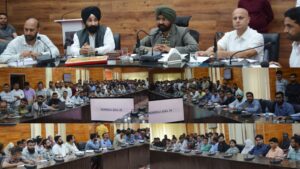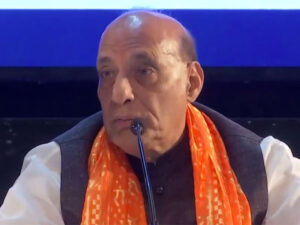Development replaces Pak shelling in J&K border villages
Jammu and Kashmir [India], April 17 (ANI): There were days when frontier villages of Jammu and Kashmir were rattled by Pakistan shelling and people used to live under constant fear, threats and intimidation but after August 5, 2019, when the Centre announced its decision to scrap J-K’s special status and bifurcated it into two Union Territories–border dwellers haven’t felt the need to demand underground bunkers or migrate to safer places.
Instead, they have sought schools, hospitals, better roads and other facilities.
After 2019, the border areas in Jammu and Kashmir have turned from sleeping hamlets into vibrant places. Facilities which the people had not even dreamt of have been provided to them.
When Article 370 was scrapped Prime Minister Narendra Modi and Union Home Minister Amit Shah had promised the people of J-K and Ladakh that their destinies would change and both leaders have remained true to their words.
The government has not disappointed them. It has provided them with all the facilities. The helmsmen have ensured that the benefits of the centrally sponsored schemes reach the border residents and they are treated at par with every Indian citizen.
Under the vision of PM Modi, frontier villages have become the first priority for development. The Centre has expedited the development of border areas and equipped every village with basic facilities and modern technology.
Despite relations between India and Pakistan being in a deep freeze the ceasefire agreement which India and Pakistan armies entered into in February 2021, has held good for the past three years. Both sides have ensured that the truce is strictly maintained.
While the LoC is calm, attempts to smuggle weapons and drugs using drones, mainly from areas of Jammu, continue. But the security forces have been successful in foiling the attempts of the anti-peace elements.
Pertinently, guns in the frontier villages of Jammu and Kashmir roared for 30-long years. Pakistan Army supported the terrorists to cross the Line of Control (LoC) and the International Border by providing them with “cover fire”.
It’s an open secret that all the infiltration bids from 1990 to 2021 were facilitated by the Pakistan Army.
According to the officials in 2021, the infiltration bids have come down and in 2022, no terrorists infiltrated J-K from across the LoC. Over the last two years, there have been no casualties reported on either side in cross-border firing in J-K. The Army’s robust counter-infiltration mechanism has curbed infiltration along the LoC.
The main idea to have peace along the LoC revolved around mitigating the sufferings of the local population and it has worked to a great extent.
Notably, for seven decades border dwellers in Jammu and Kashmir faced many problems, compelling large sections of the population to migrate to towns.
After the abrogation of Article 370, a temporary provision in the Constitution, the government has paid significant attention to eliminating the poverty and backwardness of the border areas.
The government has been focusing on human resource development so that people living in border areas are given an opportunity to showcase their talent and capabilities.
They are being encouraged to equally participate in the development. A new dawn of development has broken in all the areas close to LoC and the International Border.
The executing agencies are carrying out the development works at a rapid pace as specific deadlines have been fixed for them to deliver.
Not only are the government officials reaching out to the residents of the border areas, but the Union Ministers under the ‘Vibrant Villages Programme’ is also visiting the last villages to address people’s issues and ensure that these hamlets are developed as per their aspirations.
Under the ‘Vibrant Villages Programme’, the Government of India has envisaged building infrastructure, promoting tourism and ensuring other requisite facilities in border villages across the country.
Talking about the Border area development programme (BADP), the Union Home Affairs Ministry is implementing the Border Area Development.
The BADP is a programme of the Central Government to bring about the development of border areas by supplementing the UT Plan Funds to bridge the gaps in socioeconomic infrastructure on one hand and improving the security environment in border areas on the other.
New revamped BADP schemes launched by the Ministry of Home Affairs have further accelerated the development.
The BADP aims to meet the unique developmental requirements of frontier areas and to develop essential infrastructure in these villages.
Meanwhile, the government opening up border areas like Keran, Gurez, Karnah, Machil, and Bangus in Kashmir for tourists has opened new employment avenues for the natives. These areas from no-go zones have turned into scenic tourist destinations, which have remained abuzz with visitors during the past two years.
The Union Ministry for Roads, Transport and Highways has undertaken massive road connectivity projects in far-flung areas.
Road projects worth Rs 65000 crore are being built in Jammu and Kashmir. The border roads which didn’t exist earlier are being constructed. The government is putting in efforts to keep the border areas connected with the mainland throughout the year. The construction of tunnels to bypass snowbound roads has commenced and very soon these projects will be completed.
Emphasis is being laid on providing facilities like electricity, quality education, quality health care facility and mobile/internet connectivity.
Besides developing tourism infrastructure in border areas, the border dwellers are getting a reservation in government jobs. Last year two border battalions were constituted to employ the youth in the armed forces. There were 1,350 posts – 675 for each battalion.
The Village Defence Groups (VDGs) in the border villages have been provided with arms training and laced with sophisticated weapons to defend their communities from terror attacks. The VDGs are under the direct charge of SP/SSP.
Army Goodwill Schools (AGS) in remote areas are imparting education to children. Approximately more than one lakh fifty thousand students have benefitted from these schools after 1990 when a Pakistan-sponsored insurgency broke out in the Himalayan region.
Moreover, the Indian Army has been preparing youth from far-flung areas to take part in competitive examinations and is also providing dedicated training to them so they could be recruited under the ‘Agniveer’ scheme.








